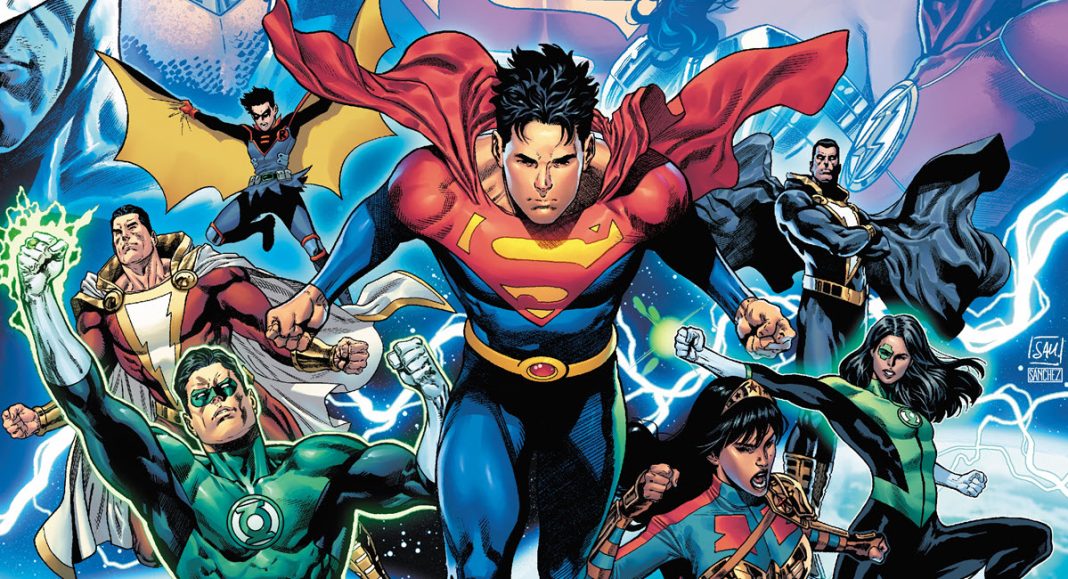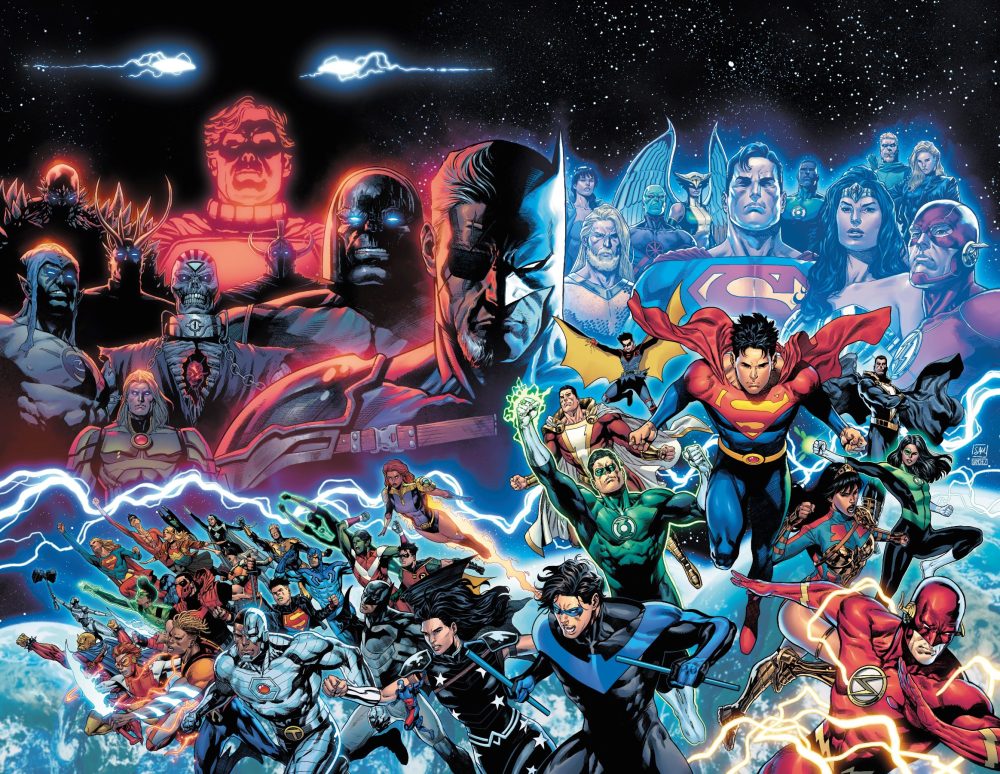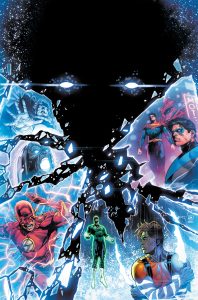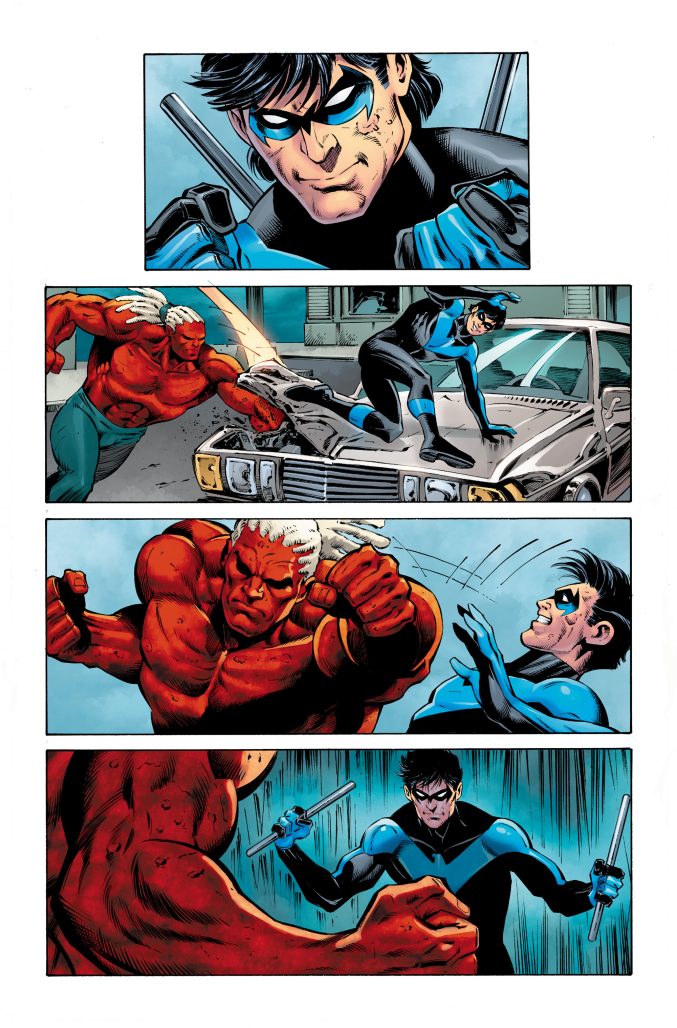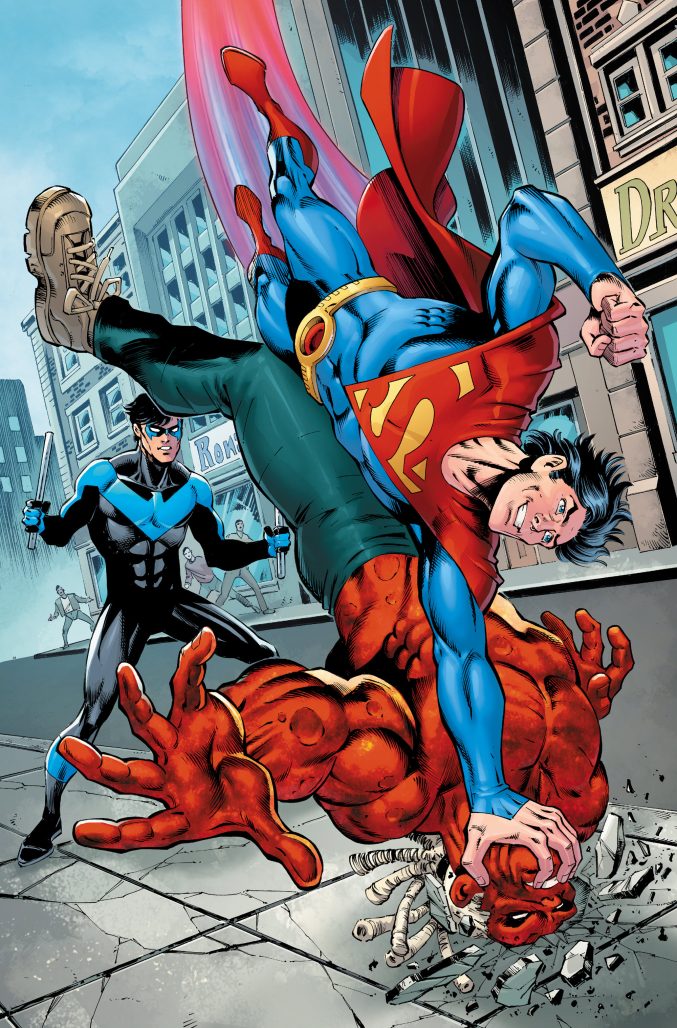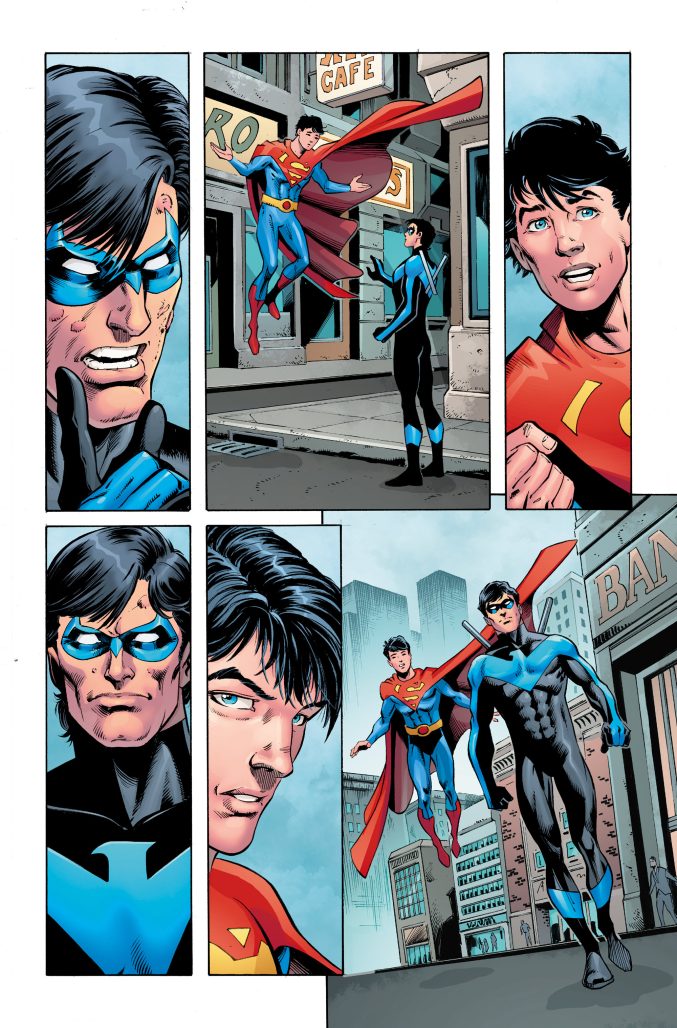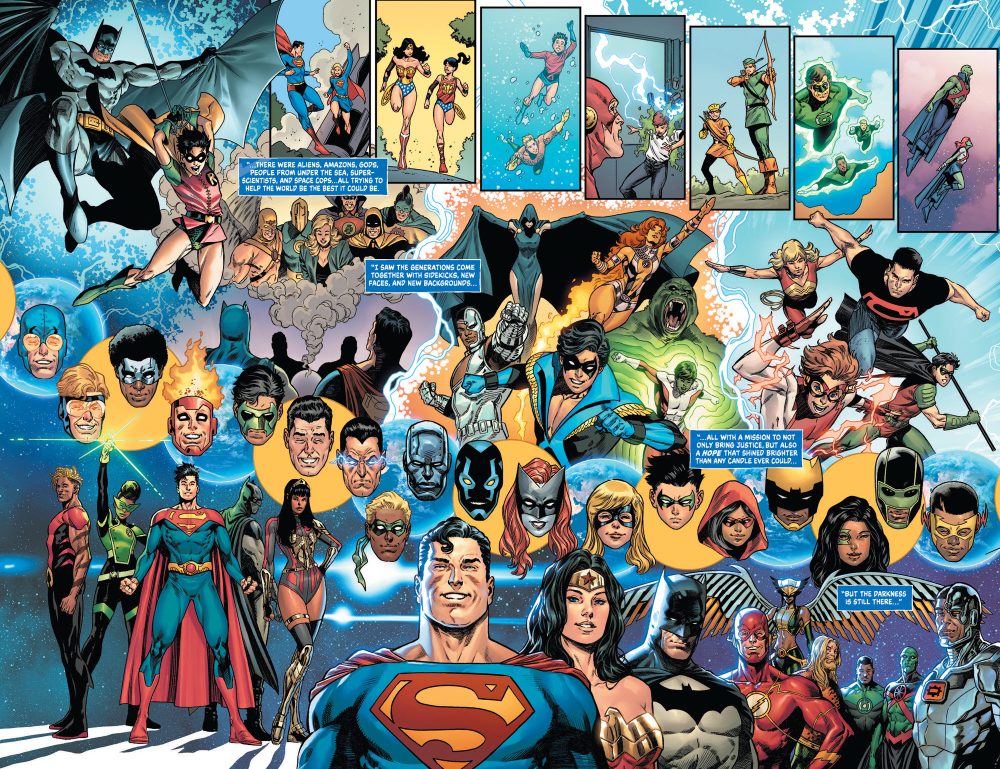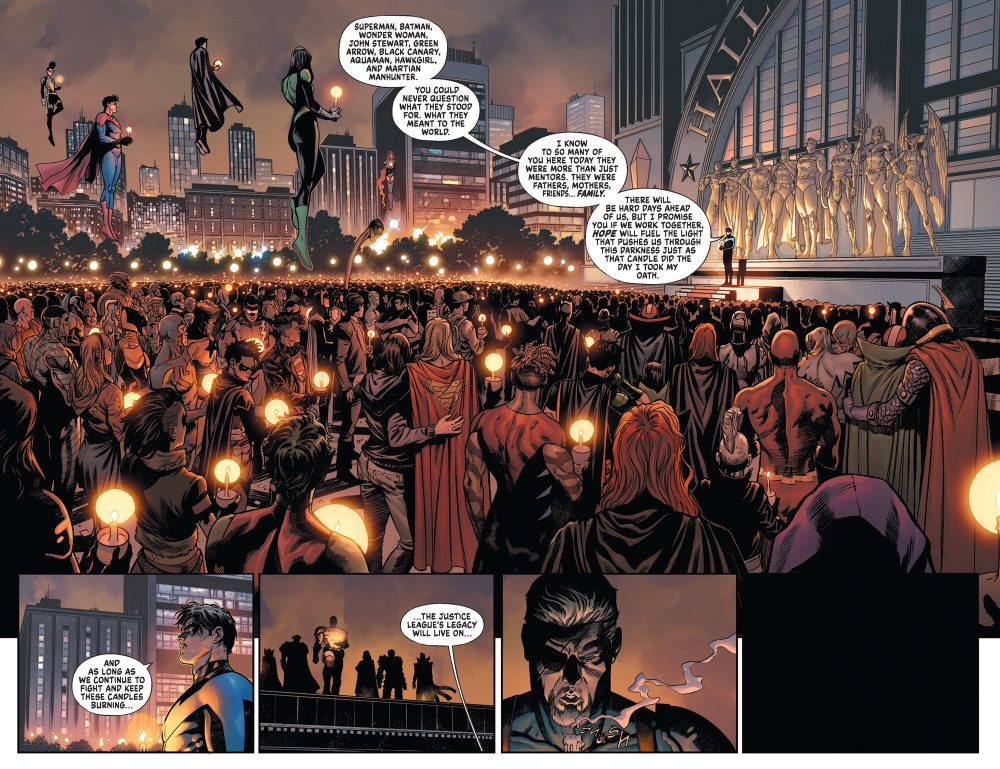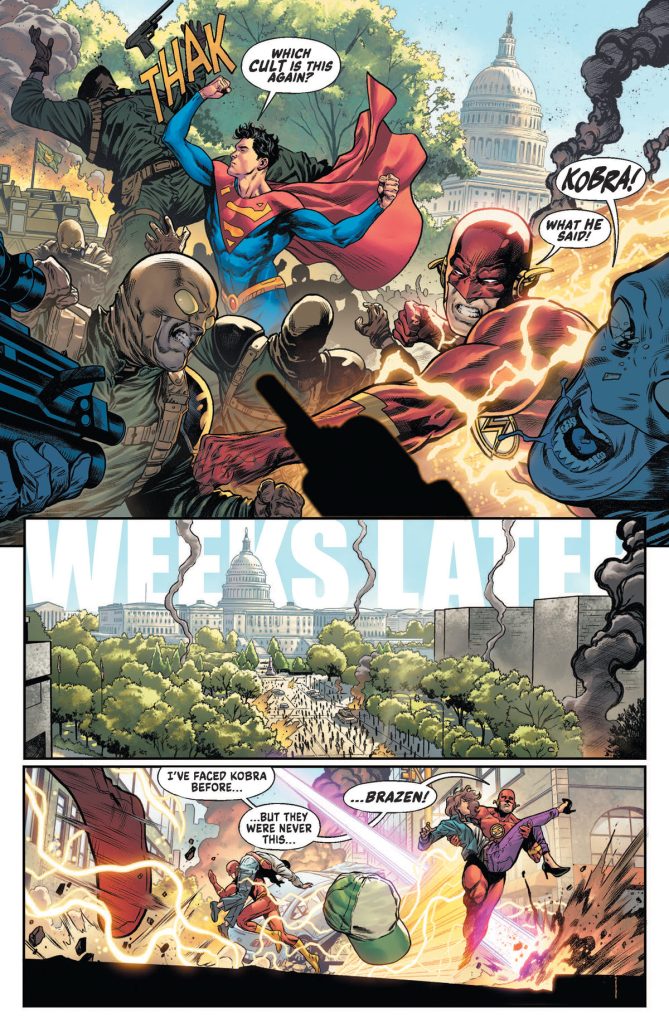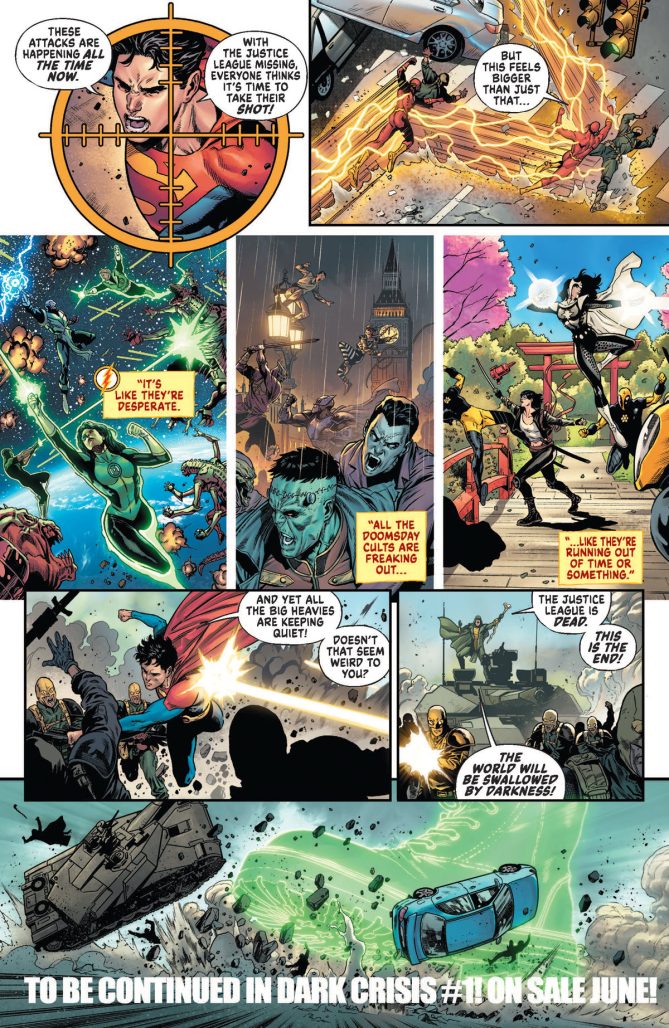The Justice League is gone. Last month’s Justice League #75 featured “The Death of the Justice League,” which saw the team of the world’s greatest superheroes fall in battle against Pariah and his Dark Army. The story, along with this past weekend’s Free Comic Book Day one-shot, helps set the stage for Dark Crisis, the next DC Comics event storyline, written by Joshua Williamson and illustrated by Daniel Sampere.
Dark Crisis is the concluding act of the über-storyline that Williamson has been telling in the DC Universe over the past year, beginning with the Infinite Frontier one-shot and continuing through the miniseries of the same title and the Justice League Incarnate miniseries. At the end of this month DC will release a Justice League: Road to Dark Crisis one-shot, with Dark Crisis kicking off officially the first week of June.
The Beat chatted with Williamson about both the prelude one-shot and the main event itself, what inspired DC’s latest Crisis, and the role legacy plays in the DCU and in this story in particular.
Joe Grunenwald: Let’s start by talking about the Road to Dark Crisis one-shot. I think people sort of have a preconceived notion about what event tie-ins and preludes and stuff like that are, so I just want to want to sort of hear from you know. What role does this book play in the overall Dark Crisis story?
Joshua Williamson: Well, I think there were some questions as we were developing dark crisis, and we knew what we were doing with “Death of the Justice League,” we knew what we were doing with Dark Crisis, I would have these meetings with editorial and certain questions would come up. And one of the questions came up was Nightwing. We knew Nightwing plays a very, very important part of Dark Crisis, but then it was like, ‘Well, why doesn’t Jon go to Nightwing first? Why isn’t he the first person he goes to?’ And I was like, ‘You’re right. He should do that first.’ So we decided, let’s tell that story, let’s talk about him going to Nightwing first. Part of it was, “Death of the Justice League” is very much this big blockbuster, Michael Bay action movie thing, right? That’s what I was going for. It’s a very over-the-top, action, big budget summer blockbuster thing. But then, my favorite parts of DC, not only the connections and the relationship between the characters, but I like some of the smaller stories. I like some of the quieter moments. And so I was like, ‘Alright, let’s do some of that.’ Because “Death of the Justice League” is all big explosions. And then issue one [of Dark Crisis] has a bunch of stuff going on in it, and we knew we were gonna connect with Flash, and we knew we’re gonna connect to Shadow War. So I was like, ‘Let’s slow down a little bit. Let’s do something where we’re able to actually see characters react to what’s going on.’ And that was sort of the directive with this. Let’s slow down for a moment, and bridge all of these stories, but do it in a way that feels a little more grounded, and that just lets the characters breathe and actually react to what’s happening.
And so that’s why we have the story with Flash where we get to see Wally and Wallace react to the news and how they handle it differently. We get to see Nocturna, a villain, and how she reacts to it, how Spoiler reacts to it. Pariah’s story is a little different. I don’t think everybody knows who Pariah is, and so it was like, let’s tell a story about Pariah. And then, you know, having Jackson and Hal, and see how they react to it, and also kind of bring Hal into the story because Hal is also a major part of Dark Crisis. So all these things were about, let’s bring some of these pieces together and show the different reactions across the DCU, in just, like, different corners. That was sort of the goal of it. And I felt like, again, so much of Dark Crisis can be like [snaps fingers rapidly] this sometimes, you know, and especially when you get to issue two. Issue two is really fast. It’s like a fast read, and I wanted to find places to just quietly slow things down for a moment. And that was the goal with Road to Dark Crisis.
Grunenwald: You mentioned a little bit about your lead story, which is a Jon Kent and Dick Grayson story. The two of them had a recent team up, and they have great interactions and a great dynamic together. What do you like about writing the two of them together?
Williamson: There’s a sort of mentorship a little bit. You look at what Tom Taylor has been doing in Nightwing and in Son of Kal-El, and you can see the relationship he’s been building with them. I think the idea of like, Nightwing is the legacy that worked, right? Nightwing is the one. And so I think whenever you have these conversations about legacy characters, you have to look at Nightwing. And with Jon, I think we’ve talked about before that, I believe that the conversations we have in the real world, the characters are also having in certain places, right? And I think Jon really looks up to Nightwing in a way that’s different. It’s different than the way that like say, Tim [Drake] looks up to him. And so writing them together it’s kind of like, ‘I’m the new kid, but I have a lot of responsibility on me and I have a lot of weight on me.’ I think that Nightwing also feels a lot of weight on him, but they react to it differently.
Early in that story Nightwing is telling Jon about the two different deaths, right? And he’s like, Bruce reacted to [Superman’s] death one way. He says Bruce reacted by not acting worried, and by putting on a front that he was not worried. And then Clark reacted when Bruce died, very worried and stressed out. And that is what is happening in this story. Dick is putting on a front that he’s not worried, and Jon is really stressed out. It’s the same, and that parallel was what I was trying to go for what that story. The story that Dick tells about both of their parents is what they’re both doing. And they’re both being their parents, they don’t realize it. I think that’s the kind of stuff that’s really fun to write about them. They’re so much like their dads, but they don’t really totally put that together yet.
And, you know, also just seeing them hanging out. I like watching superheroes eat sometimes and just hang out. I wanted to see them hang out for a minute. I was talking to Dan Jurgens about it when we were working on it. And I was like, ‘I just wanna see them eat. Can we just do that?’ Dan does very big, bombastic action, but he knows the characters really well, and he was like, ‘Yeah, you definitely need to bring it down a little bit. You gotta ground it.’ Especially because the other things are so big and epic that I’m like, ‘Let’s just let them eat at food carts for a few pages. Make them more human for a while.’ And but yeah, I enjoy writing them together. I actually sent the scripts for my story to Tom Taylor, because I’m like, ‘These are your boys. How are you feeling about this?’ And he was really positive and had a couple of comments, but they were all really good. Yeah, I’m really happy with that one.
Grunenwald: You mentioned Dan Jurgens. I feel like his drawing this story really cements Death of the Justice League’s tie to Superman #75’s anniversary. What is that like for you to work with him as a writer and also just as a fan?
Williamson: It is super surreal. There are times where Dan and I will just text you know, and it’s so weird. I remember waiting in line in the rain for Superman #75. I loved all that Superman stuff. I remember that particular era of Superman, the triangle-numbered Superman, I was obsessed with it. I remember I used to take all those issues and I would like lay them on the ground, and just look at them, like, ‘Oh, that’s so cool.’ And I like the stories, everything. I’ve gotten to be in a writers room with Dan a couple of times and had some conversations with him, and we get along really well. And so every once in a while I would just chat with Dan on the phone, and we’ve gotten to do a couple little things together. This is our first time where I wrote something and he drew it. And I mean, there was nobody else that could do it. It had to be Dan. There’ll be these moments where Dan’ll just text me and I definitely get like, ‘This is so weird, Dan Jurgens is texting me.’ [laughs] I always say though, I don’t have time to fanboy out too much. There’s too much work to do. So I have those moments, those moments lasts for a minute, and then I’m like, ‘Alright, cool, we’ll get back to work. Let’s just get going.’ It’s really surreal, but it’s also really exciting. And I always feel really honored by it, to get to work with somebody who’s done so much legendary DC work. It’s really cool.
Grunenwald: That’s awesome. Beyond the story that you wrote yourself for the one-shot, how closely did you work with the creators on the other stories? Was that a thing where you went to them with an idea, or did you just say, ‘This is where they are? Do something with it?’
Williamson: I basically gave them sort of prompts. So it’s like, with Stephanie [Phillips], I got on the phone with Stephanie and I was like, ‘Let’s do a villain story.’ We talked about some stuff, and I suggested some characters. I gave her a list and I’m like, ‘This is who’s in Deathstroke’s army, so we should pick from this list.’ And then we talked through it and then she was like, ‘I kind of want to do Nocturna. I have this whole thing about Nocturna and Batman and Spoiler,’ and I was like, ‘This is perfect. Yes, do that.’ And the only thing that we ended up really talking about was who was on the last page. And then with Philip Kennedy Johnson, he and I just got on the phone, and I was like, We need to showcase who Pariah is and their motivation. I’m obsessed with Pariah so I was able to relay a bunch, but then Philip went and did like a ton of his own research and brought some stuff on the table which is really cool. Jeremy Adams and I are friends, so we just chat through a lot of stuff. We had a couple phone calls, but we just knew what his was gonna be, and he ran with it and did a great job. And then I’m friends with Brandon Thomas. He’s the Aquamen writer, he co-writes it with Chuck Brown. And so I was able to talk with him a bit, and then Chuck wrote it and I gave a few notes. Most of these were all a really easy process of pulling it all together, and it was fun. It’s just fun to work on. This is definitely a lot of work, but it’s fun.
Grunenwald: Nice. Yeah, the Nocturna story in particular I really enjoyed.
Williamson: Oh, good. Yeah, it’s cool to see a villain kind of like struggling with the idea of like, ‘Oh, Batman is not here to catch me this time.’
Grunenwald: Yeah, well, and I did a Jason Todd project a few years ago. So I read every Jason Todd appearance and Nocturna played a huge part in that.
Williamson: She’s a forgotten character. It’s so interesting how important she was to Batman at one point, and then it’s just like, it’s all kind of forgotten. And that’s why I thought it was cool that Stephanie brought that stuff back.
Grunenwald: Talking a little bit more about Dark Crisis in general. Maybe it’s just me, but I read the first issue, and knowing a little bit about what it’s about, it’s sort of feels like a reaction to 5G. Like, ‘Oh, well, you were gonna have the new generation step up? Well, this is what that looks like. Let’s take the original generation completely off the table and have this happen.’ Am I reading too much into that? Or was that something you had in mind?
Williamson: That was not necessarily in my head. I always wanted to tell a big story about the sidekicks. That’s really more where it came from. I really wanted to do story about the sidekicks, like the new generation. Not just the newer characters like Yara [Flor] and Jace [Fox] and Jon, but like the Tim Drakes, the Kyle Rayners, and then again, going back to Nightwing and the Titans. What I really wanted to do is tell a story about all of the, I guess you call them next generation characters, right? Like, all of the not-Justice League characters. I always wanted to do a story about that. And you can kind of see a bit of that with Infinite Frontier, that was the beginning of that. I wanted to do a story about different points of view.
Really, to be honest with you, I think it was more about the idea that, like, I’ve seen a crisis from the Justice League perspective. Let’s do it from somebody else’s perspective, and that involves all the new characters. And then, if you’re gonna have all these new characters, they need to be challenged. And so I was like, alright, let’s challenge all of these new characters. And when I say new, I’m not just talking about the characters from the last couple of years, I’m talking about characters that are maybe 30 years old. But I’m like, let’s tell a story about that. And then, as Dark Crisis goes, you’ll see other generational characters show up, and other pieces that are too early to spoil.
It’s not really about a reaction to 5G so much as it was my desire to tell a story about all these different generations and legacy, and how DC only works, or I don’t want to say only, but I think DC works its best when all these pieces are working together. My favorite era of DC is when there was a JSA book, there was a JLA book, there was Titans, there was Teen Titans, there was Legion of Super-Heroes, you had multiple books from multiple different families. And to me, that’s when DC is working at its best, so I kind of wanted to talk about that. Like, let’s have all these different families of characters, and put them through a crisis. We’ve seen Superman and Batman and Wonder Woman deal with a Crisis a few times, so now let’s see somebody else deal with the Crisis and how they react to it. That was more what was in my head. If I’m going to do a Crisis, I want to do it differently. And I’m obsessed with all that stuff, so I’m like, ‘Alright, it’s gotta be a crisis with things I’m obsessed about.’ So I’m way more obsessed with [telling] a story about the sidekicks than anything else.
Grunenwald: Gotcha. I suspected maybe I was reading too much into it, but I was just curious.
Williamson: I’m really curious what people are gonna think when they start to read it. I know issue one is definitely going to be — I mean it’s issue one of a book called Dark Crisis, it’s going to be a little hard. But I think as you go, you’ll start to see what is actually happening with the story and I think people will be really happy by the time we get to the ending.
Grunenwald: Nice. So, you know I’m a Wally West guy. It’s exciting to me to see Wally front and center again, in a Crisis book where he’s, you know, not-terrible things are happening. You didn’t get to write a ton of him during your Flash run. What’s your approach to writing him, headspace-wise, versus writing Barry?
Williamson: I love Barry, but Barry is a bit of a nerd, and he’s a bit more lost in his head, and I don’t think he actually has as much fun being The Flash as Wally does. I think that Wally really enjoys being The Flash. He also grew up with it. I think it’s a different experience when you grew up with something, you look up to it, and then you get to do it. I mean, that’s kind of like me, you know, as a comic book writer, loving comics and then getting to write comics. I can kind of relate to that. Whereas I think Barry feels a bit more like it’s something he has to do. Not is a burden, though. That was a big part of my Flash run, I did not want it to be about a burden. Part of the ending of my Flash run was I wanted to make sure it was very clear that Barry is The Flash not because of tragedy, but because it’s the right thing to do. I wanted to hit that part at the ending. But with Wally, I think Wally just enjoys it differently, and I think he has a lot more fun with it. You know, it’s always interesting, I very much have a voice for both those characters in my head. Barry’s not a jokey character. He’s not supposed to make jokes. He’s not supposed to be funny. So whenever I see people write him like that I’m always like, ‘Oh, no no no, that’s Wally. Wally does that. Wally’s a bit more loosey-goosey about these things.’
If you remember before “The Return of Barry Allen,” part of the running thing with Wally was that he was kind of irresponsible. He won the lottery, and he had all these different relationship problems, and you know, all these weird things with him, and then he kind of came into his own, he stepped out of the shadow and became his own person, his own hero. And I think that gives him his own perception on a lot of the stuff. And that’s why he says that thing to Jon [in issue 1], he talked to Jon about like, ‘You’ve got to find your own way out of the shadow.’ Right. Wally is the one, just like Nightwing is, he’s also the one that made it. Wally got to step up and really step into those shoes, no pun intended, and he was able to run with it.
So one of the things with Dark Crisis is this: it’s about legacy, but it’s also about different people’s perception on legacy. Nightwing has his understanding of legacy. So does Wally and the Flash Family, they’ve embraced the idea of legacy, and they feel like, it is something you do, you pass the torch, the family grows, like they understand that, Wally gets that. Black Adam is very conflicted on the idea of legacy, because Black Adam has had a family before that were his legacy characters, and they died. So I think for him, he has a very conflicted feeling about legacy. He’s not against it, but he isn’t necessarily for it, and I think he looks down on Billy Batson for sharing his power with his family.
Then you get somebody like Hal, who also embraces legacy as a piece of it, right? He is a legacy character. And he knows that he also likes the idea of sharing it with his friends. But then you get somebody like Deathstroke, and Deathstroke hates legacy, it is built into him. And it’s not a rational feeling, because he will never take responsibility for his own actions and being a terrible father, but he believes all these bad things have happened to his children because of legacy, and because of the Titans. The Titans represent legacy in a lot of ways, right? So their archenemy is Deathstroke, and he hates legacy. He hates the idea of the kids. He hates the idea of anyone picking up a torch. And so for him, he just wants to destroy legacy. And so I wanted to play with all those different points of view with legacy and that’s the kind of stuff that I like playing with in the story.
The Justice League: Road to Dark Crisis #1 one-shot is due out in stores and digitally on Tuesday, May 31st. A second printing of Justice League #75 featuring the Death of the Justice League also arrives in stores that day. Dark Crisis #1 is set for release the following week, on Tuesday, June 7th.


